How to prepare the Perfect Matcha
You've got your matcha and your kit, you've seen some video's on how to make your matcha but are still not really sure. I'm here to help!
I think the making of matcha can sometimes be displayed as something really complicated, maybe more due to the very complicated people create with it. and even though I love the creativity, I do believe that is is often a pity of the product to mix it with tons of sugar/syrups/creams etc.
With a high quality matcha like Awaken Matcha's first flush matcha, I would recommend to keep it simple in your daily routine, to really appreciate the drink as is, without covering it's unique taste too much.
I hear you asking now, what about a matcha latte? I won't lie, I love my matcha latte. and the main reason I start my days with a matcha latte instead of drinking it pure, is because I drink mine as part of my morning routine, before having breakfast. It is not recommended to consume your matcha pure on a empty stomach. the milk in this case serves as a barrier. This is also why I often drink 2 matcha's a day. One matcha latte in the morning and one pure matcha in the afternoon.
- As matcha does contain caffeine, I recommend to not drink it first thing in the morning, but at least 30 minutes after waking. (this goes the same for coffee btw)
Now, let's break some things down before we more to the actual instructions.
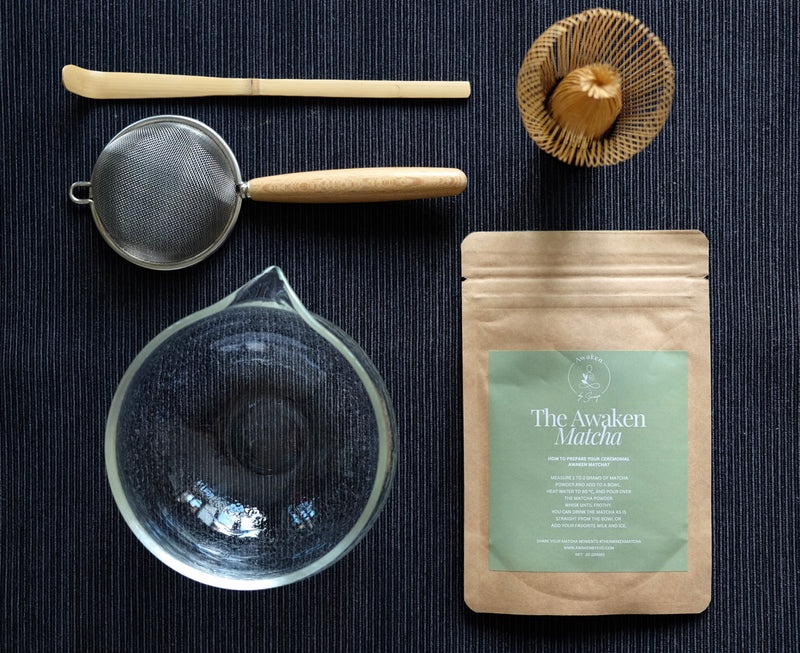
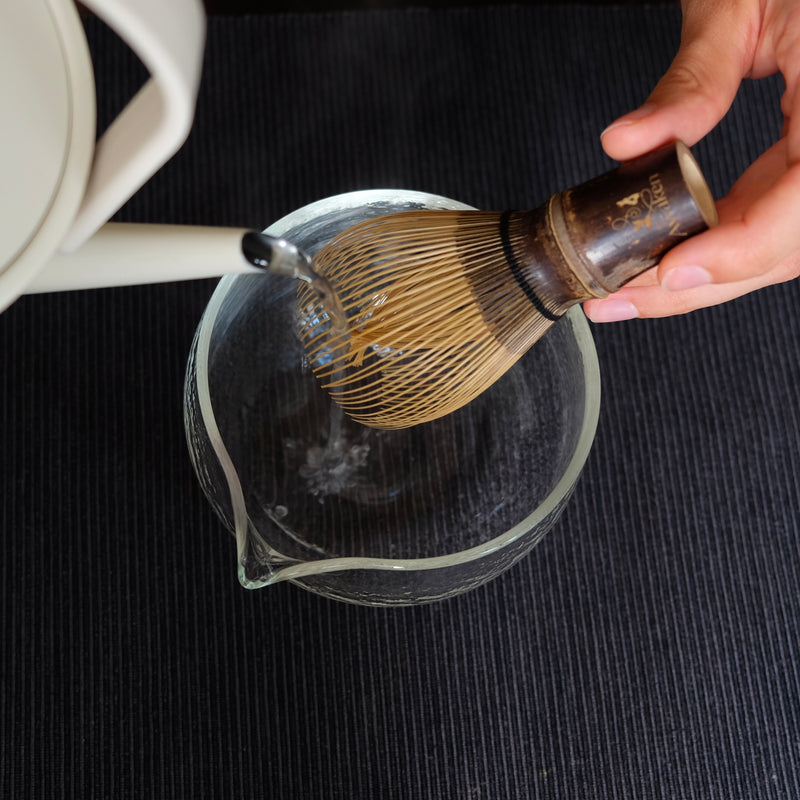
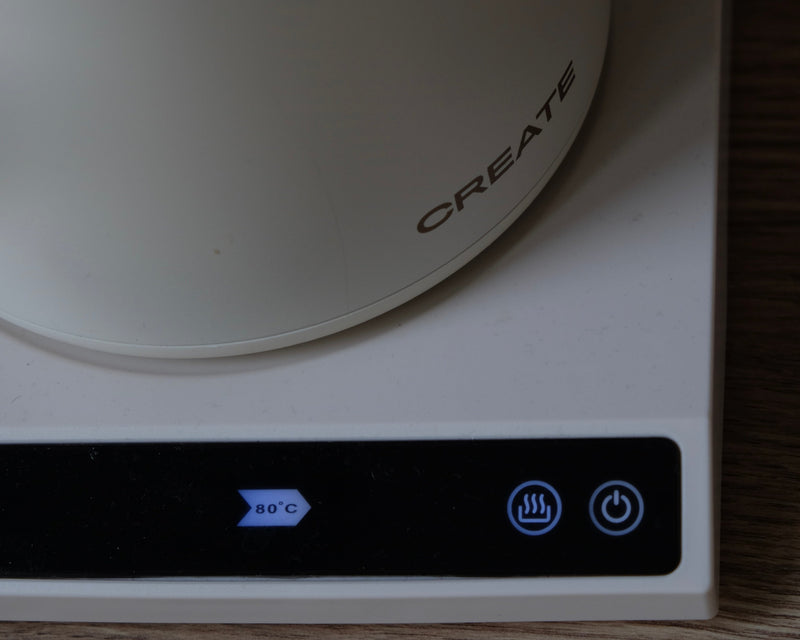
Water
We can be very specific when it comes to water, but the basics are that best is soft water, so not from the tap (unless you have soft water running from the tab, then good for you!) It is also important to respect the temperature threshold, why? not because you will burn the matcha, that's not really correct. it has everything to do with the extraction of components from the leaves. With matcha you as not creating an extraction like with loose leaf tea, with matcha you are drinking the whole leaf. Until max. 80 degrees celsius the component l'theanine (amino acid) will be extracted the most, l'theanine gives matcha it's sweet and umami taste. Above 80 degrees celsius the extraction of catechins and caffeine will be overtaking the extraction of the l'theanine, these two components give the matcha it's bitterness and astringent taste. That is why it is recommended to use water that has a temperature between 70 and 80 degrees celsius.
Even with a high quality matcha like Awaken, if you don't have a trained palate you might still experience a hint of bitterness when drinking it as a pure matcha.
You don't have a temperature controlled water boiler? No problem, we'll just go a little step back in time, because of course in the past they did not exist either. You can either bring your water to a boil, then pour the water in a cup (just the amount you need) and let it sit for around 30 seconds to one minute (depending on the temperature in your home and the season) this will cool your water down to the right temperature. If you want to play it on the safer side you can also do 50/50 half boiled water, half cold water. and the last option is to not let your boiler to get to a full boil.
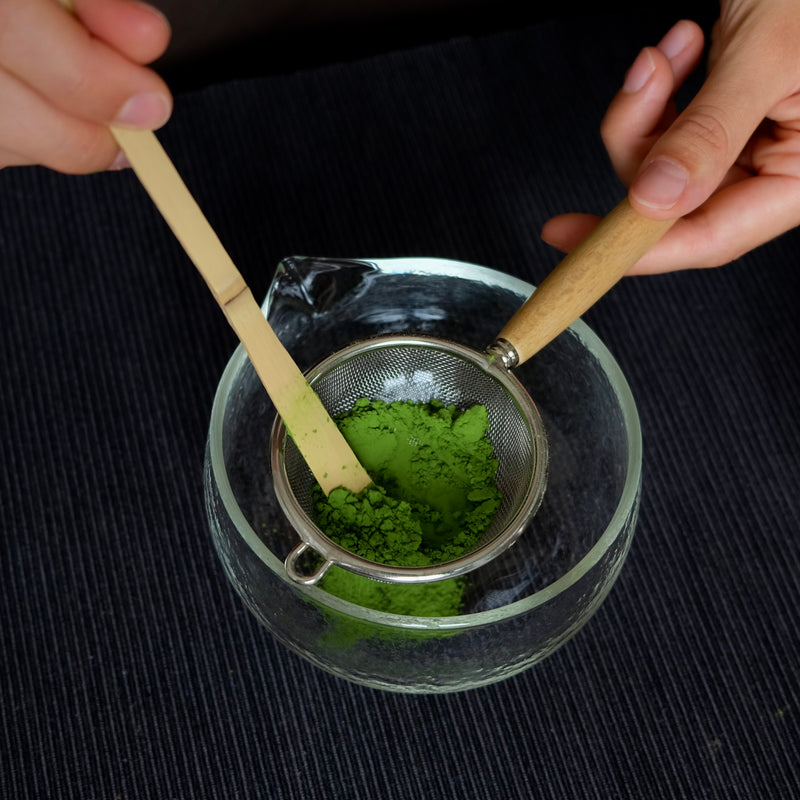
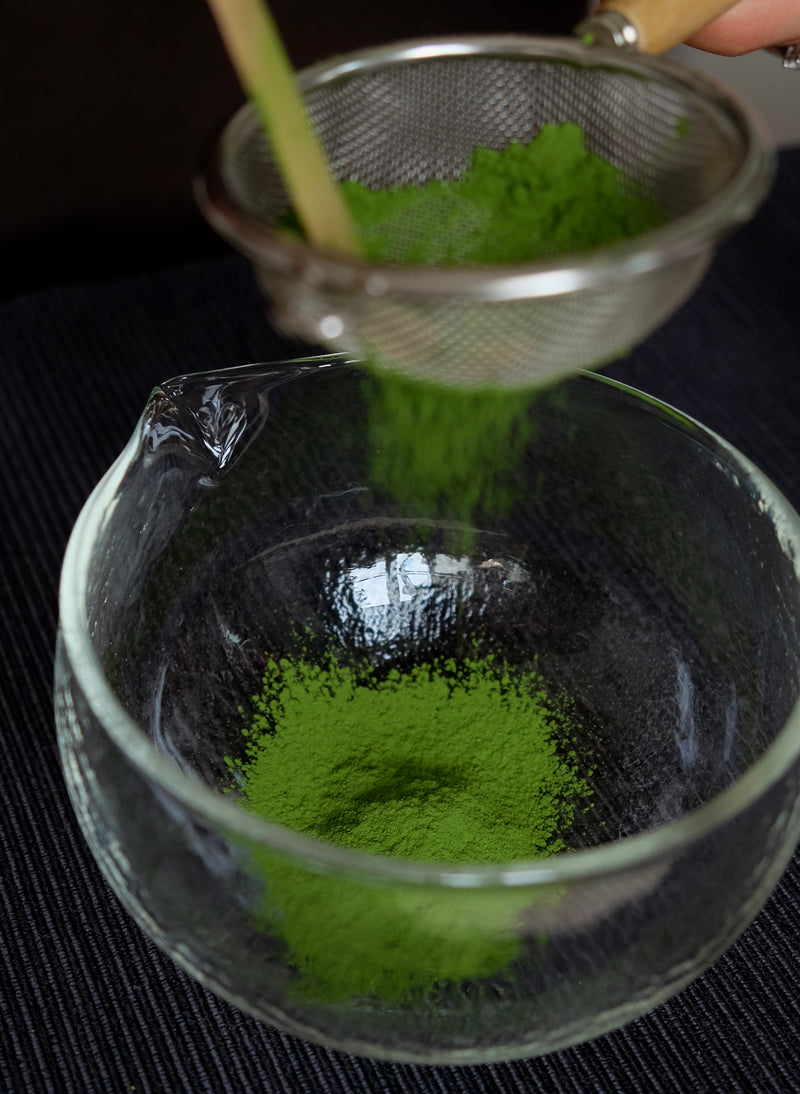
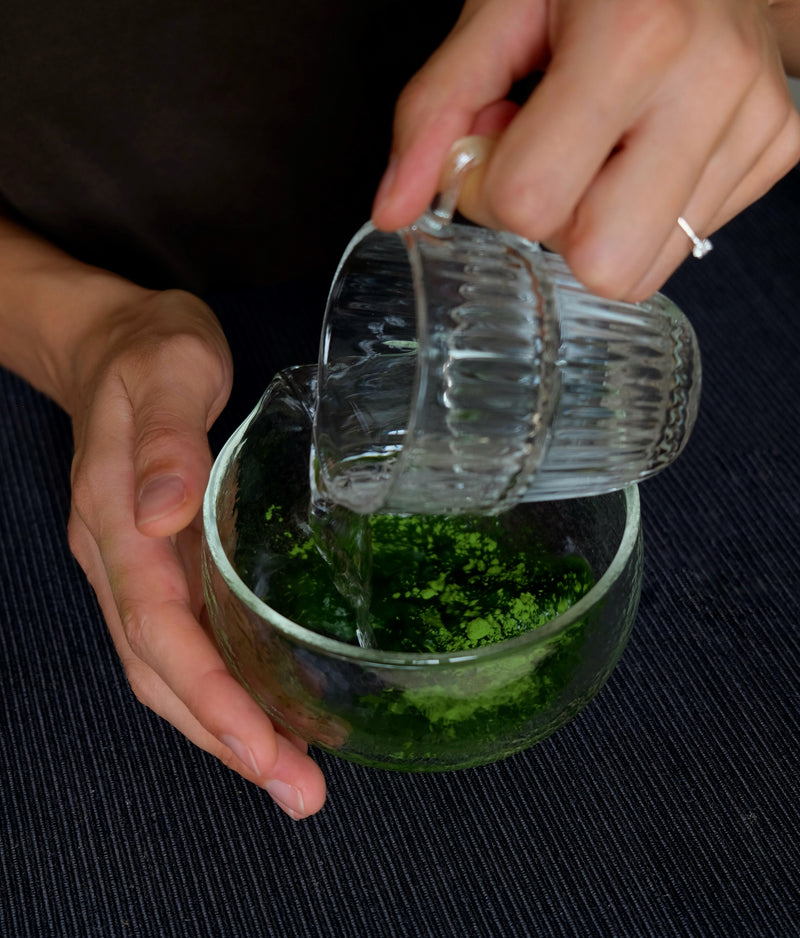
Milk
I like to play with my milk, in general I would recommend you to look for milks that are as pure as possible, without any unnecessary additional ingredients. You can also make your plant based milks at home, which is actually quite a fun activity. As I have a lactose intolerance I would not be able to tell you which animal based milks I would recommend. But I did want to share some of the things I found while trying different milks and what type of matcha latte you can get out of it.
- Oat milk - if you like your drink naturally sweeter.
- Coconut milk - this depends very much on the brand, but generally speaking I think coconut milk pairs really good with matcha. It gives it a slight sweetness but not too overpowering, and the creaminess makes it an amazing combination. I would recommend this both hot or iced.
- Cashew milk (homemade) - super easy to make, really creamy and frothy, and does not have an overpowering taste. I would mainly recommend this for hot drinks.
- Almond milk - I find it very difficult to find a nice tasting one. what I noticed it that when the almonds have been roasted and the milk contains almonds (at least 8%) and not almond paste it is generally better. It foams a lot, so not great if you are looking to create some latte art. This I would recommend for either iced or hot matcha.
- Hazelnut milk - believe me when I say that this is a secret weapon. This one is for when you need something special, it is a bit overpowering in taste, so I would recommend to make your matcha a bit stronger when making it with this milk.
The greenness of your drink often also has to do with the type of milk used, not only the amount of matcha used. Cow's milk tends to cover a lot of the green color, the same goes for some almond milks. With oat and cashew it stays quite neutral and coconut milk does not cover at all and shines the beautiful green of the matcha through.
In the end it is all about personal taste, so just consider this as my opinion but try different options for yourself. Oh and you can also mix types of milk, I am currently loving half oat half coconut. so in the end the options are unlimited.
Oh, and you can also mix types of milk, I am currently loving half oat half coconut. so in the end the options are unlimited.
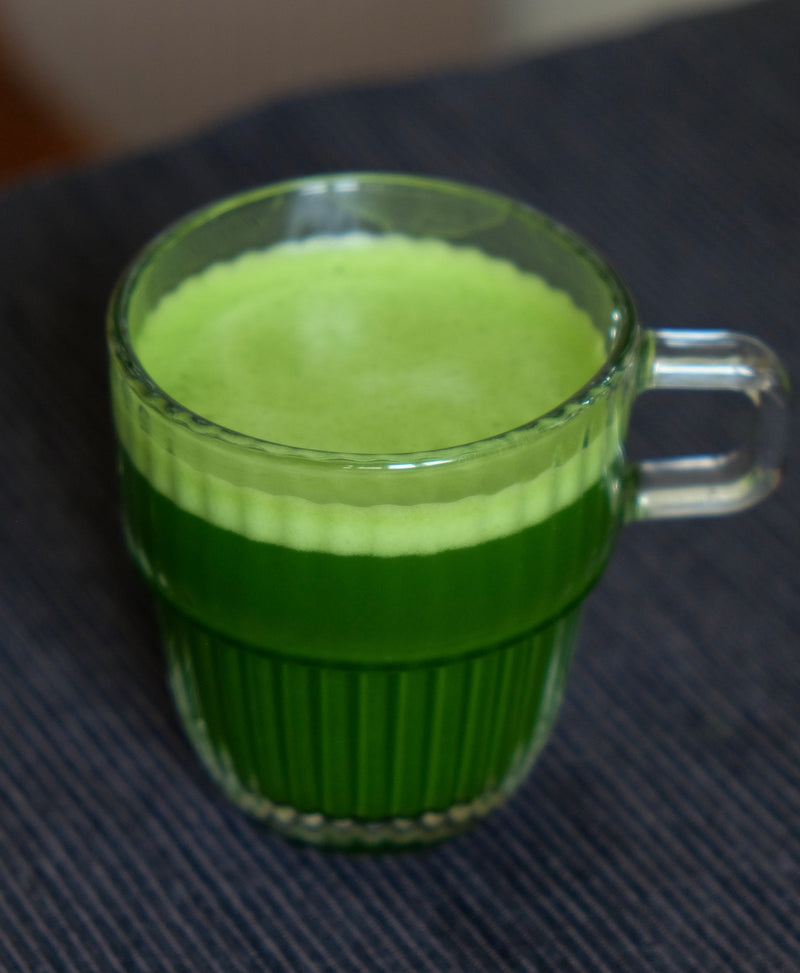
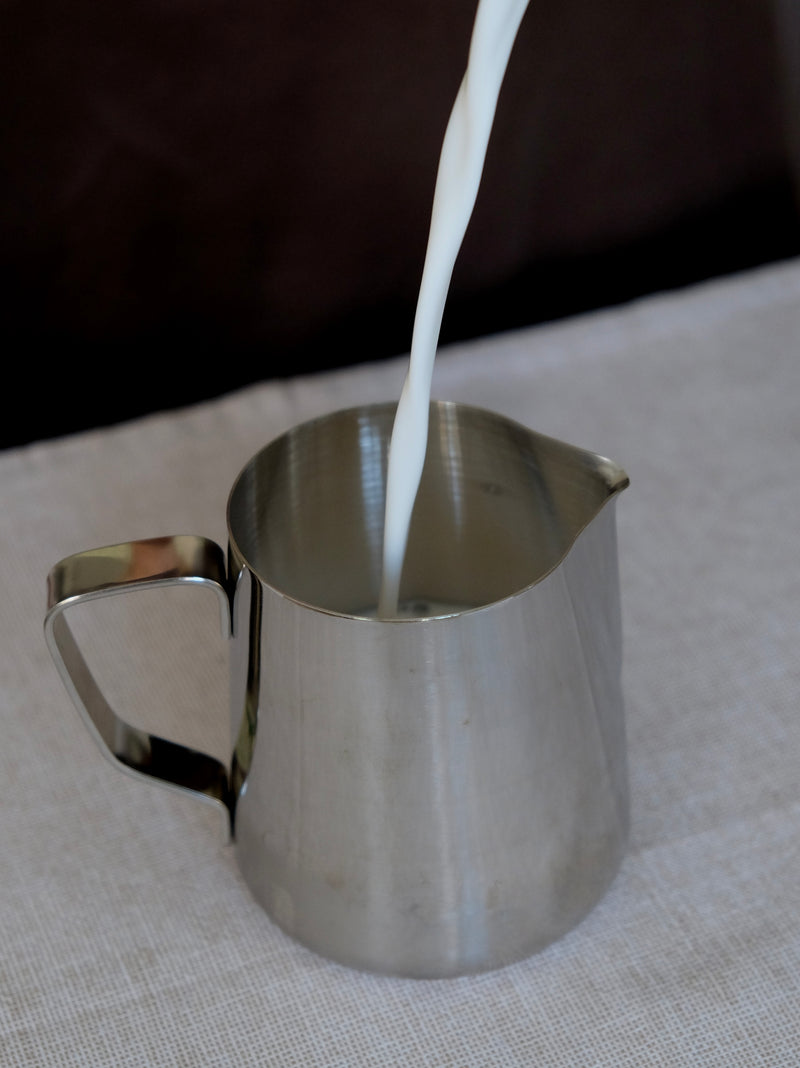
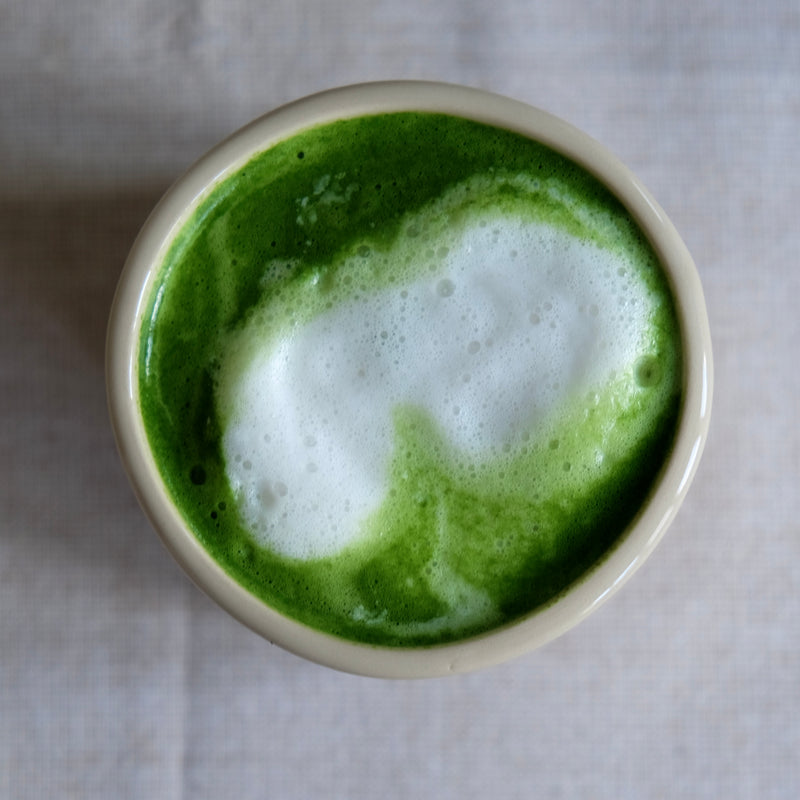
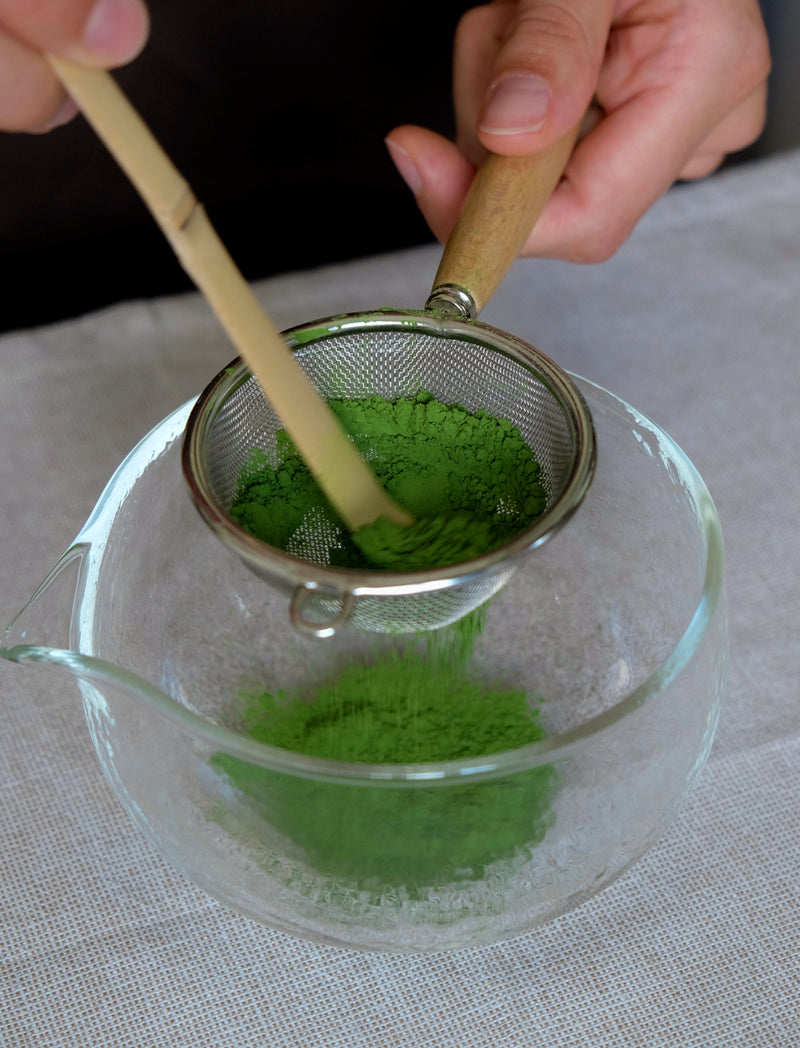
Sweetener
I cannot and don’t want to tell you what you should and shouldn’t do. But here’s my take on adding sweetener to your matcha. If you feel like it’s absolutely necessary because otherwise you find it undrinkable, it might be worth looking at the quality of the matcha you’re using. Lower-quality matcha often tastes very bitter or flat, which is why it’s harder to enjoy without covering it up. A high-quality matcha naturally has a balance of sweetness, umami, and slight bitterness, and that complexity is what makes it so special.
Matcha is not just another green powder, it’s a product with centuries of tradition, meant to be enjoyed in its pure form. It’s full of health benefits, including a very high amount of antioxidants, and I think it’s a pity to hide that behind too much sugar or syrup. Every now and then, sure, go ahead. But try not to make it the standard.
If you’re just starting out with Awaken Matcha and aren’t yet used to the taste, start slow. Use a little less powder in your drinks at first, and allow your palate to adjust over time. Often, people who thought they “didn’t like matcha” simply hadn’t tried a good one, or hadn’t given themselves the chance to ease into its unique flavour.
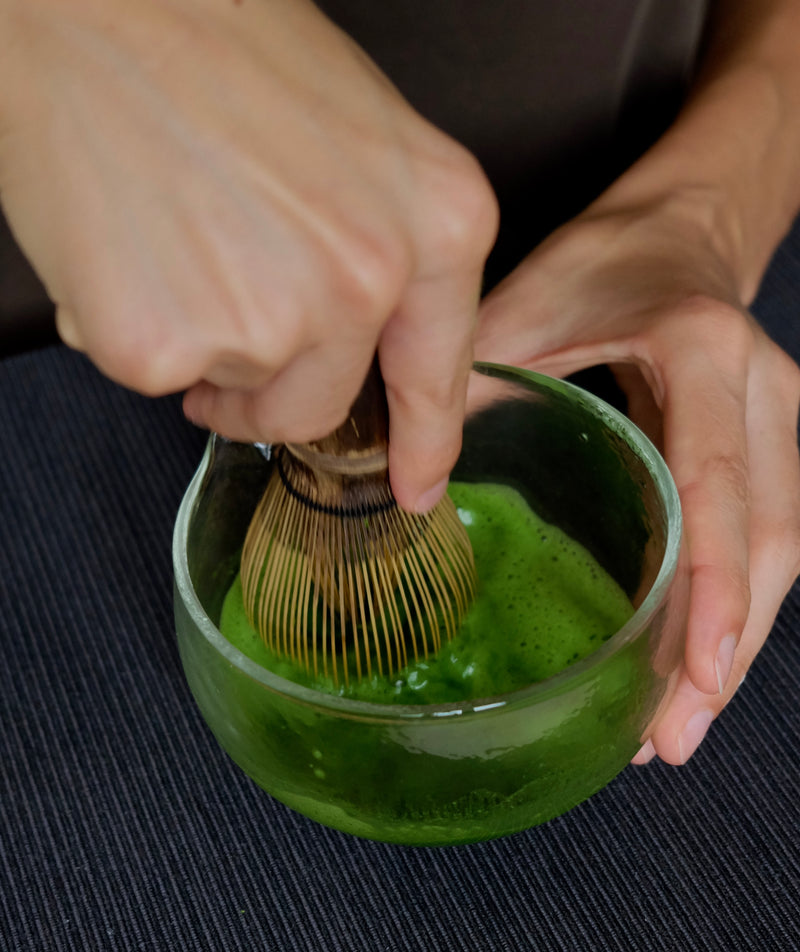

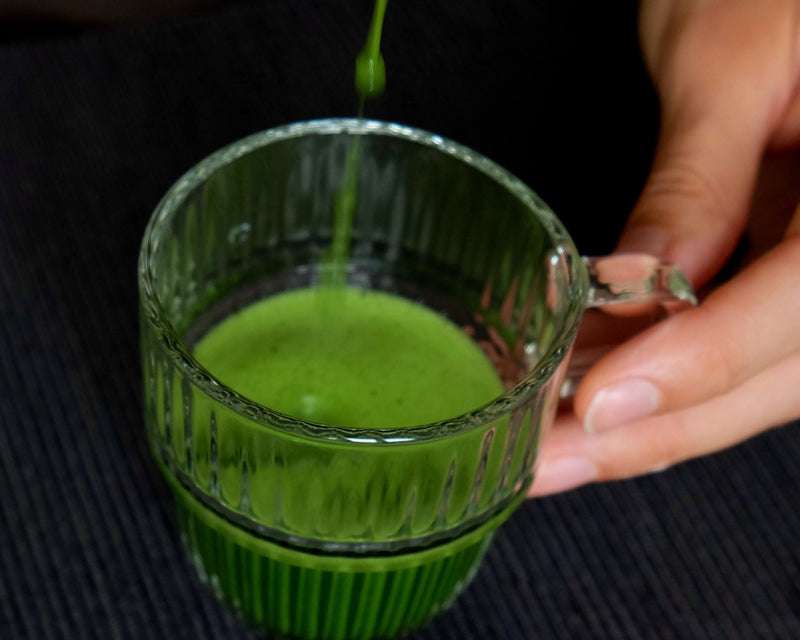
How to prepare the perfect cup of Matcha
Follow the below steps to create the perfect cup of pure matcha:
- heat your water till 80 degrees celsius
- take your bowl pour some of the water in it, and place the chasen in it to soak. make sure to not place too much water in the bowl, the cotton string should not get wet. let this sit for 30 seconds to 1 minute.
- place the chasen on this whisk holder while you empty and dry the bowl with a dry cloth. You have now not only soaked the whisk, but also heated the bowl. which help the matcha to 'open up' and release more of it's aroma.
- place your sifter diagonally over the chawan.
- take your pouch of matcha, carefully open it, and carefully take in the aroma of the powder that is settling down in the bag.
- with your bamboo spoon, scoop 1 to 2 scoops of matcha. as a beginner start with one. and carefully push it through the sifter to remove any clumps.
- remove the tools, and slowly pour around 60ml of water over the matcha
- place the chasen in the bowl, hold it in a soft and relaxed manner, move the chasen around the bowl to remove any matcha from the sides, and then continue to make a W or M motion. Try to keep a rhythm without applying too much pressure, it helps to move from your wrist. do this for 20 - 30 seconds.
- add more water to your liking. Drink it as is, straight from the bowl or a cup.
optional: pour the prepared matcha over some ice. this makes a very refreshing and delicate drink.
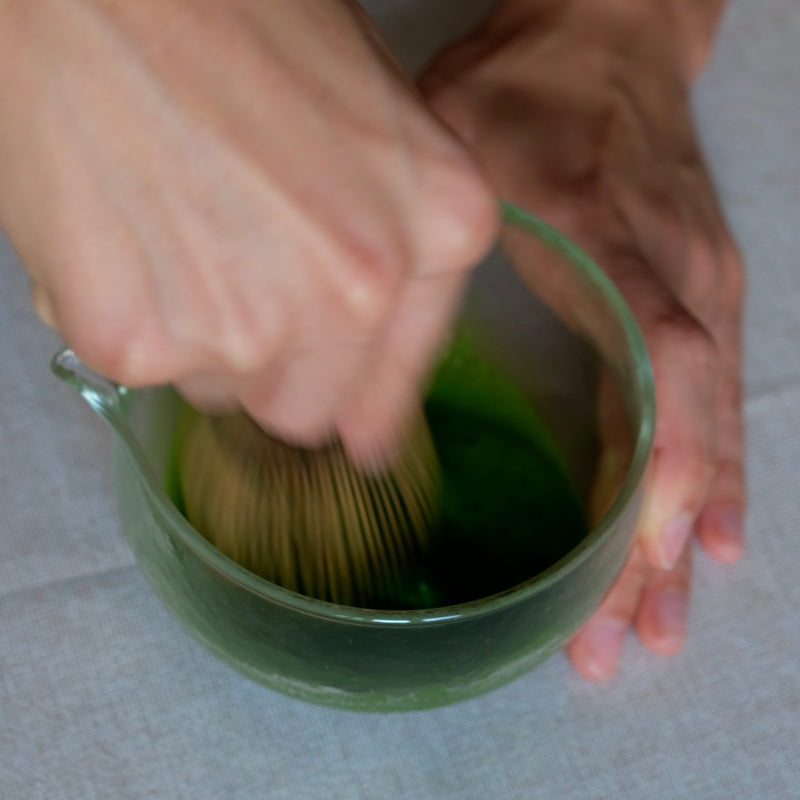
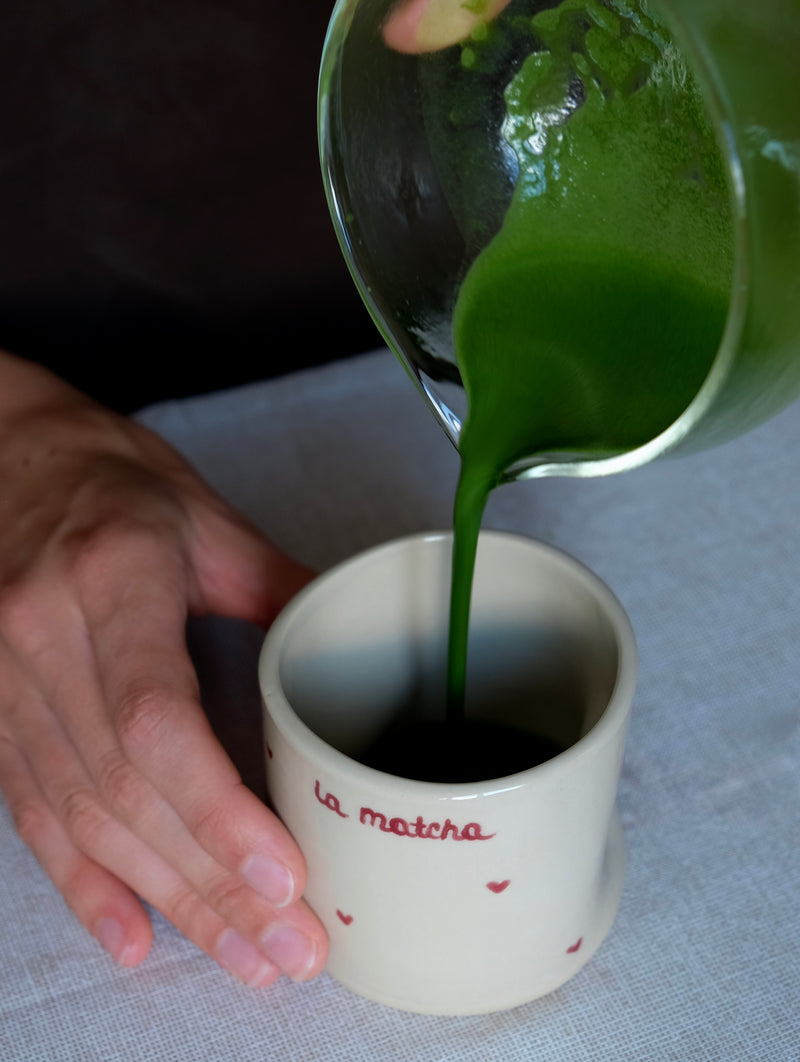
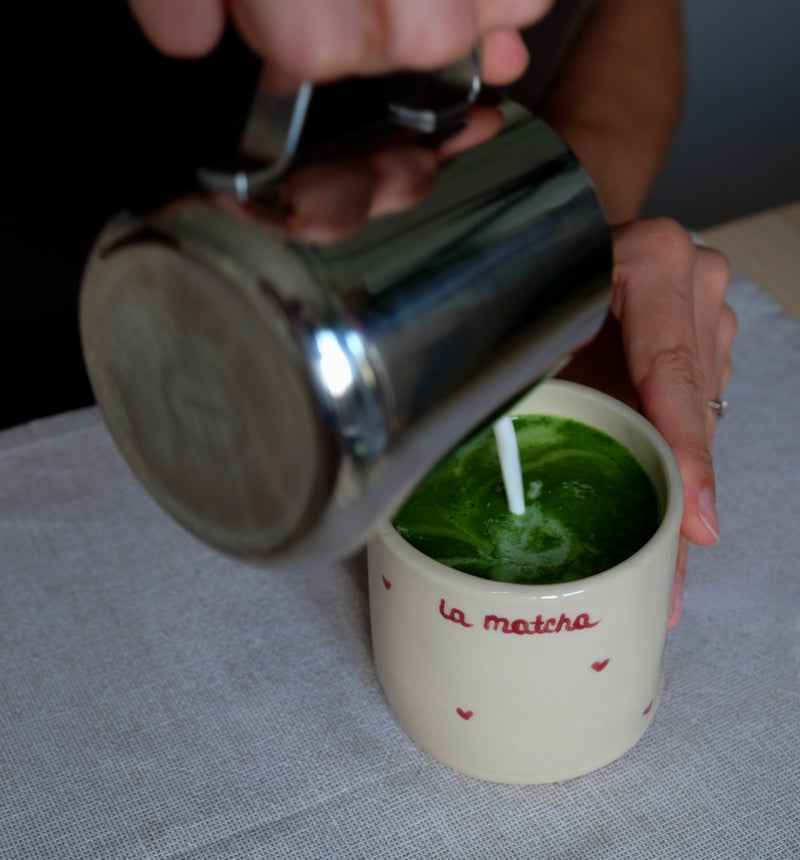
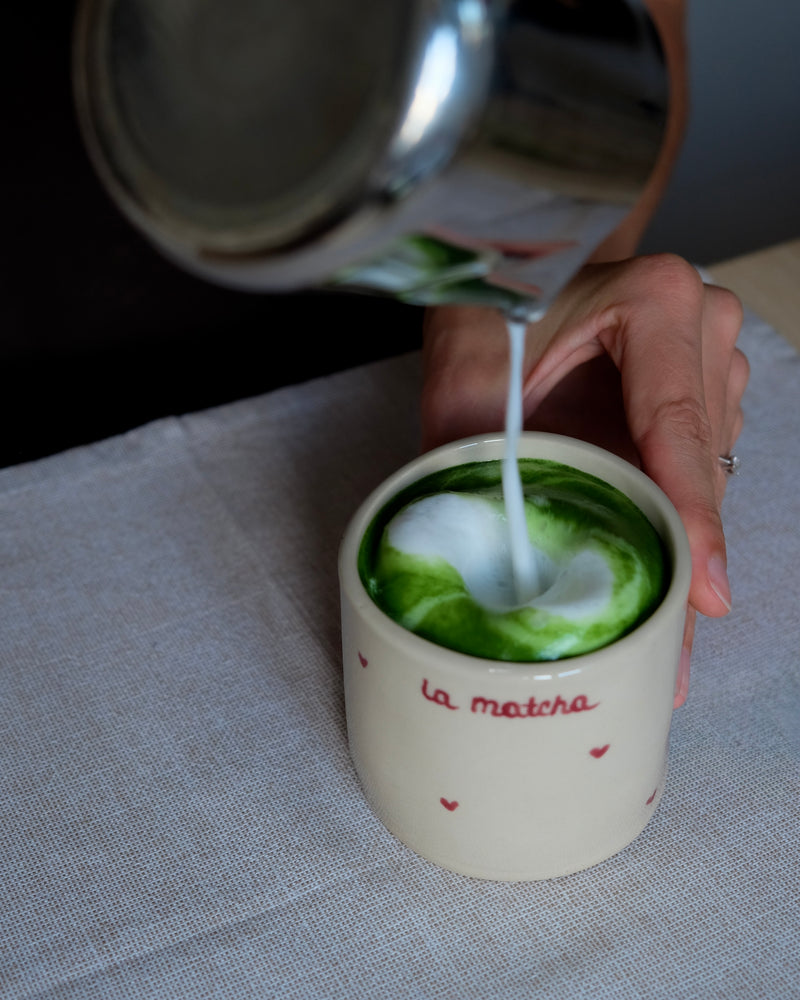
How to make the perfect Matcha latte
Follow the below steps to create the perfect matcha latte:
- heat your water till 80 degrees celsius
- take your bowl pour some of the water in it, and place the chasen in it to soak. make sure to not place too much water in the bowl, the cotton string should not get wet. let this sit for 30 seconds to 1 minute.
- place the chasen on this whisk holder while you empty and dry the bowl with a dry cloth. You have now not only soaked the whisk, but also heated the bowl. which help the matcha to 'open up' and release more of it's aroma.
- place your sifter diagonally over the chawan.
- take your pouch of matcha, carefully open it, and carefully take in the aroma of the powder that is settling down in the bag.
- with your bamboo spoon, scoop 2-3 scoops of matcha (3 grams) and carefully push it through the sifter with the spoon to remove any clumps.
- remove the tools, and slowly pour around 30-40 ml of water over the matcha
- place the chasen in the bowl, hold it in a soft and relaxed manner, move the chasen around the bowl to remove any matcha from the sides, and then continue to make a W or M motion. Try to keep a rhythm without applying too much pressure, it helps to move from your wrist. do this for 20 - 30 seconds.
- pour the matcha mixture into your favorite cup
- heat and froth the milk you have chosen for today's morning ritual and pour it on top of the matcha mixture.
Iced matcha latte: prepare your matcha in the same way as described above, you can in this case also use cold water for the preparation. add first the ice and milk to a glass and pour the matcha on top.
Let’s remember: with so many things already going on in our lives, and so many things we have to rush for, making matcha can be a ritual of stillness, slowing down and being present. Wherever you prepare it, wherever you enjoy it, let the slow process of its cultivation continue with you, and use it as a moment to take care of yourself (and your loved ones).
Come prepare la Matcha Perfetta
Hai il tuo matcha e il tuo kit, hai visto qualche video su come preparare il tuo matcha ma non sei ancora del tutto sicura/o. Sono qui per aiutarti!
Credo che la preparazione del matcha venga a volte mostrata come qualcosa di davvero complicato, forse più per via delle creazioni molto elaborate che le persone fanno con esso. E anche se amo la creatività, penso che sia spesso un peccato mescolare un prodotto del genere con tonnellate di zuccheri/sciroppi/panna ecc.
Con un matcha di alta qualità come il first flush di Awaken Matcha, ti consiglierei di mantenerlo semplice nella tua routine quotidiana, per apprezzare davvero la bevanda così com’è, senza coprirne troppo il gusto unico.
Ora ti sento chiedere: e il matcha latte? Non mentirò, amo il mio matcha latte. E il motivo principale per cui inizio le mie giornate con un matcha latte invece che berlo puro è perché lo bevo come parte della mia routine mattutina, prima di fare colazione. Non è raccomandato consumare il matcha puro a stomaco vuoto. In questo caso il latte funge da barriera. Questo è anche il motivo per cui spesso bevo due matcha al giorno: un matcha latte al mattino e un matcha puro al pomeriggio.
Dato che il matcha contiene caffeina, consiglio di non berlo appena sveglia/o, ma almeno 30 minuti dopo il risveglio. (vale lo stesso anche per il caffè).



Acqua
Possiamo essere molto specifici quando si parla di acqua, ma la base è che la migliore è l’acqua dolce, quindi non dal rubinetto (a meno che non abbiate acqua dolce che esce dal rubinetto, in quel caso fortunati voi!). È anche importante rispettare la soglia di temperatura, perché? Non perché “bruceresti” il matcha, non è proprio corretto. Ha tutto a che fare con l’estrazione dei componenti dalle foglie. Con il matcha non stai creando un’infusione come con il tè in foglie, con il matcha bevi l’intera foglia. Fino a max. 80 °C viene estratto principalmente il componente l-teanina (amminoacido), che conferisce al matcha il suo gusto dolce e umami. Sopra gli 80 °C l’estrazione di catechine e caffeina supera quella della l-teanina: questi due componenti danno al matcha il suo sapore amaro e astringente. Per questo motivo si raccomanda di usare acqua a una temperatura tra i 70 e gli 80 °C.
Anche con un matcha di alta qualità come Awaken, se non hai un palato allenato potresti comunque percepire un leggero sentore di amaro bevendolo puro.
Non hai un bollitore con controllo della temperatura? Nessun problema, facciamo un passo indietro nel tempo, perché ovviamente in passato non esistevano. Puoi portare l’acqua a ebollizione, versarla in una tazza (solo la quantità che ti serve) e lasciarla riposare per circa 30 secondi - 1 minuto (a seconda della temperatura in casa e della stagione). Questo la porterà alla temperatura giusta. Se vuoi andare sul sicuro puoi anche fare 50/50 metà acqua bollita, metà acqua fredda. Un’ultima opzione è quella di non portare il bollitore a completa ebollizione.



Latte
Mi piace giocare con i tipi di latte, in generale ti consiglierei di cercare latti il più puri possibile, senza ingredienti aggiuntivi inutili. Puoi anche preparare i tuoi latti vegetali in casa, che è in realtà un’attività piuttosto divertente. Avendo un’intolleranza al lattosio non potrei consigliarti latti animali, ma voglio condividere alcune cose che ho scoperto provando diversi latti e il tipo di matcha latte che puoi ottenere.
- Latte d’avena – se ti piace la bevanda naturalmente più dolce.
- Latte di cocco – dipende molto dalla marca, ma in generale credo che si abbini molto bene al matcha. Dona una leggera dolcezza senza essere troppo invadente, e la cremosità lo rende una combinazione fantastica. Consigliato sia caldo che freddo.
- Latte di anacardi (fatto in casa) – super facile da preparare, molto cremoso e spumoso, e non ha un sapore troppo marcato. Lo consiglio soprattutto per bevande calde.
- Latte di mandorla – trovo difficile trovarne uno davvero buono. Ho notato che quando le mandorle sono tostate e il latte contiene mandorle (almeno 8%) e non pasta di mandorle, è generalmente migliore. Fa molta schiuma, quindi non ideale se vuoi fare latte art. Consigliato sia caldo che freddo.
- Latte di nocciole – credimi se ti dico che è un’arma segreta. Da usare quando vuoi qualcosa di speciale. Ha un gusto un po’ invadente, quindi ti consiglio di preparare il matcha un po’ più forte.
Il colore verde della bevanda dipende spesso anche dal tipo di latte usato, non solo dalla quantità di matcha. Il latte vaccino tende a coprire molto il verde, lo stesso vale per alcuni latti di mandorla. Con avena e anacardi rimane piuttosto neutro, mentre il cocco non lo copre affatto e lascia brillare il bellissimo verde del matcha.
Alla fine è tutto una questione di gusto personale, quindi considera questo solo come la mia opinione ma prova diverse opzioni. Ah, e puoi anche mischiare i latti: al momento io adoro metà avena e metà cocco. Quindi, alla fine, le opzioni sono infinite.
Ah, e puoi anche mischiare i latti: al momento io adoro metà avena e metà cocco.




Dolcificante
Non posso e non voglio dirti cosa dovresti o non dovresti fare. Ma ecco il mio punto di vista sull’aggiungere dolcificante al matcha. Se senti che è assolutamente necessario perché altrimenti lo trovi imbevibile, forse vale la pena guardare alla qualità del matcha che stai usando. Il matcha di qualità inferiore ha spesso un gusto molto amaro o piatto, ed è per questo che è più difficile da gustare senza coprirlo.
Un matcha di alta qualità ha naturalmente un equilibrio di dolcezza, umami e una leggera amarezza, ed è proprio questa complessità a renderlo speciale. Il matcha non è solo un’altra polvere verde, è un prodotto con secoli di tradizione, pensato per essere gustato nella sua forma pura. È ricco di benefici per la salute, incluso un altissimo contenuto di antiossidanti, e credo sia un peccato nasconderlo dietro troppo zucchero o sciroppo. Ogni tanto, certo, va bene. Ma cerca di non farne la regola.
Se stai iniziando ora con Awaken Matcha e non sei ancora abituata/o al gusto, comincia piano. Usa un po’ meno polvere all’inizio e lascia che il tuo palato si abitui con il tempo. Spesso, chi pensava di “non amare il matcha” semplicemente non aveva provato uno buono o non si era dato la possibilità di entrare piano piano nel suo sapore unico.



Come preparare la tazza perfetta di Matcha
Segui i passaggi riportati di seguito per preparare una tazza di matcha puro perfetta.
- Scalda l’acqua fino a 80 °C.
- Prendi la tua ciotola, versaci un po’ d’acqua e metti dentro il chasen per ammorbidirlo. Assicurati di non mettere troppa acqua nella ciotola, la corda di cotone non deve bagnarsi. Lascia riposare 30 sec - 1 min.
- Metti il chasen sul suo supporto mentre svuoti e asciughi la ciotola con un panno. In questo modo hai ammorbidito il frullino ma anche riscaldato la ciotola, cosa che aiuta il matcha a “aprirsi” e sprigionare più aroma.
- Posiziona il setaccio diagonalmente sul chawan.
- Prendi la bustina di matcha, aprila con cura e inspira delicatamente l’aroma della polvere che si deposita nel sacchetto.
- Con il cucchiaino di bambù prendi 1-2 cucchiaini di matcha (da principiante inizia con uno) e spingilo attraverso il setaccio per eliminare eventuali grumi.
- Rimuovi gli strumenti e versa lentamente circa 60 ml d’acqua sopra il matcha.
- Metti il chasen nella ciotola, tienilo in modo morbido e rilassato, muovilo per staccare il matcha dai lati e poi continua con un movimento a W o M. Mantieni un ritmo senza applicare troppa pressione, muovendo il polso. Fallo per 20-30 sec.
- Aggiungi altra acqua a piacere. Bevilo così com'è, direttamente dalla ciotola o da una tazza.
Opzionale: versa il matcha preparato su del ghiaccio. Diventa una bevanda fresca e delicata.




Come preparare il Matcha latte perfetto
Segui i passaggi riportati di seguito per preparare un matcha latte perfetto:
- Scalda l’acqua fino a 80 °C.
- Prendi la tua ciotola, versaci un po’ d’acqua e metti dentro il chasen per ammorbidirlo. Assicurati di non mettere troppa acqua nella ciotola, la corda di cotone non deve bagnarsi. Lascia riposare 30 sec - 1 min.
- Metti il chasen sul suo supporto mentre svuoti e asciughi la ciotola con un panno. Hai così ammorbidito il frullino e riscaldato la ciotola.
- Posiziona il setaccio diagonalmente sul chawan.
- Prendi la bustina di matcha, aprila con cura e inspira l’aroma della polvere.
- Con il cucchiaino di bambù prendi 2-3 cucchiaini di matcha (3 g) e spingilo attraverso il setaccio per eliminare i grumi.
- Versa lentamente circa 30-40 ml d’acqua sopra il matcha.
- Metti il chasen nella ciotola e muovilo come descritto prima per 20-30 sec.
- Versa la miscela di matcha nella tua tazza preferita.
- Scalda e monta il latte scelto per il rituale mattutino di oggi e versalo sopra al matcha.
Matcha latte freddo: prepara il matcha come sopra (puoi anche usare acqua fredda). Aggiungi prima ghiaccio e latte in un bicchiere e poi versa sopra il matcha.
Proviamo a ricordarci, con così tante cose che succedono nelle nostre vite e così tante corse quotidiane, preparare il matcha può diventare un rituale di calma, rallentare e vivere il presente. Ovunque tu lo prepari, ovunque tu lo gusti, lascia che il lento processo della sua coltivazione continui con te, e usalo come un momento per prenderti cura di te (e dei tuoi cari).
Cómo preparar el Matcha Perfecto
Tienes tu matcha y tu kit, has visto algunos vídeos sobre cómo prepararlo pero todavía no estás del todo segura/o. ¡Estoy aquí para ayudarte!
Creo que la preparación del matcha a veces se muestra como algo muy complicado, quizá más por las elaboraciones tan complejas que la gente hace con él. Y aunque me encanta la creatividad, creo que a menudo es una lástima mezclarlo con toneladas de azúcar/siropes/nata, etc.
Con un matcha de alta calidad como el first flush de Awaken Matcha, te recomendaría mantenerlo sencillo en tu rutina diaria, para apreciar de verdad la bebida tal como es, sin cubrir demasiado su sabor único.
Ya te oigo preguntar: ¿y el matcha latte? No voy a mentir, me encanta mi matcha latte. Y la razón principal por la que empiezo mis días con un matcha latte en lugar de beberlo puro es porque lo tomo como parte de mi rutina matutina, antes de desayunar. No se recomienda consumir matcha puro con el estómago vacío. En este caso, la leche actúa como barrera. Por eso a menudo tomo dos matchas al día: un matcha latte por la mañana y un matcha puro por la tarde.
Como el matcha contiene cafeína, recomiendo no beberlo justo al despertarte, sino al menos 30 minutos después. (esto vale también para el café).



Agua
Podemos ser muy específicos al hablar del agua, pero lo básico es que lo mejor es el agua blanda, no del grifo (a menos que tengas agua blanda en el grifo, ¡entonces enhorabuena!). También es importante respetar el umbral de temperatura, ¿por qué? No porque “quemes” el matcha, eso no es del todo correcto. Tiene todo que ver con la extracción de componentes de las hojas. Con el matcha no estás haciendo una infusión como con el té en hoja, con el matcha estás bebiendo la hoja entera.
Hasta un máximo de 80 °C se extrae sobre todo la l-teanina (aminoácido), que da al matcha su sabor dulce y umami. Por encima de 80 °C la extracción de catequinas y cafeína supera a la de l-teanina, y estos dos componentes aportan el amargor y la astringencia. Por eso se recomienda usar agua entre 70 y 80 °C.
Incluso con un matcha de alta calidad como Awaken, si no tienes un paladar entrenado puede que aún percibas un ligero amargor al beberlo puro.
¿No tienes hervidor con control de temperatura? No pasa nada, damos un pequeño paso atrás en el tiempo, porque en el pasado tampoco existían. Puedes hervir el agua, verterla en una taza (solo la cantidad necesaria) y dejarla reposar unos 30 segundos - 1 minuto (dependiendo de la temperatura de tu casa y la estación). Así se enfría a la temperatura adecuada. Si quieres ir sobre seguro, puedes hacer 50/50 mitad agua hervida, mitad agua fría. Otra opción es no dejar hervir el agua del todo.



Leche
Me gusta experimentar con la leche. En general te recomendaría buscar leches lo más puras posibles, sin ingredientes añadidos innecesarios. También puedes preparar tus propias leches vegetales en casa, lo cual es bastante divertido. Como tengo intolerancia a la lactosa no puedo recomendarte leches animales, pero quiero compartir algunas cosas que descubrí probando diferentes leches y el tipo de matcha latte que puedes obtener.
- Leche de avena – si te gusta la bebida naturalmente más dulce.
- Leche de coco – depende mucho de la marca, pero en general creo que combina muy bien con el matcha. Aporta un dulzor ligero pero no excesivo, y la cremosidad la convierte en una combinación increíble. Recomendada tanto caliente como fría.
- Leche de anacardos (casera) – súper fácil de hacer, muy cremosa y espumosa, y no tiene un sabor fuerte. La recomiendo sobre todo para bebidas calientes.
- Leche de almendras – me resulta difícil encontrar una realmente buena. He notado que cuando las almendras están tostadas y la leche contiene almendras (al menos un 8%) y no pasta de almendras, suele ser mejor. Hace mucha espuma, así que no es ideal si buscas hacer arte latte. Recomendada tanto fría como caliente.
- Leche de avellanas – créeme cuando te digo que es un arma secreta. Para cuando necesites algo especial. Tiene un sabor bastante intenso, así que recomiendo preparar el matcha un poco más fuerte con esta leche.
El color verde de tu bebida también depende del tipo de leche usada, no solo de la cantidad de matcha. La leche de vaca tiende a cubrir mucho el verde, lo mismo con algunas leches de almendra. Con avena y anacardos queda bastante neutro, y con coco no se cubre en absoluto, dejando brillar el verde hermoso del matcha.
Al final todo depende del gusto personal, así que considera esto solo como mi opinión pero prueba diferentes opciones. Ah, y también puedes mezclar tipos de leche: últimamente me encanta mitad avena y mitad coco. Así que, en definitiva, las opciones son infinitas.
Ah, y también puedes mezclar tipos de leche: últimamente me encanta mitad avena y mitad coco.




Endulzante
No puedo ni quiero decirte lo que deberías o no deberías hacer. Pero aquí tienes mi opinión sobre añadir endulzante al matcha. Si sientes que es absolutamente necesario porque de otro modo te resulta imbebible, quizás valga la pena revisar la calidad del matcha que estás usando. El matcha de baja calidad suele saber muy amargo o plano, por eso cuesta más disfrutarlo sin cubrirlo.
Un matcha de alta calidad tiene de forma natural un equilibrio entre dulzor, umami y un ligero amargor, y esa complejidad es lo que lo hace tan especial. El matcha no es simplemente otro polvo verde, es un producto con siglos de tradición, pensado para disfrutarse en su forma pura. Está lleno de beneficios para la salud, incluido un altísimo contenido de antioxidantes, y creo que es una pena esconderlo detrás de demasiado azúcar o sirope. De vez en cuando, claro que sí. Pero trata de que no sea lo habitual.
Si estás empezando con Awaken Matcha y aún no te acostumbras al sabor, empieza poco a poco. Usa un poco menos de polvo al principio y deja que tu paladar se adapte con el tiempo. A menudo, la gente que pensaba que “no le gustaba el matcha” simplemente no había probado uno bueno, o no se había dado la oportunidad de acostumbrarse poco a poco a su sabor único.



Cómo preparar la taza perfecta de Matcha
Siga los pasos que se indican a continuación para preparar una taza perfecta de matcha puro.
- Calienta el agua hasta 80 °C.
- Toma tu cuenco, vierte un poco de agua y coloca el chasen para que se ablande. Asegúrate de no poner demasiada agua, la cuerda de algodón no debe mojarse. Déjalo reposar 30 seg - 1 min.
- Coloca el chasen en su soporte mientras vacías y secas el cuenco con un paño. Así no solo has suavizado el batidor, sino también calentado el cuenco, lo que ayuda a que el matcha “se abra” y libere más aroma.
- Coloca el colador diagonalmente sobre el chawan.
- Abre con cuidado la bolsa de matcha e inhala el aroma del polvo.
- Con la cuchara de bambú toma 1-2 cucharaditas (como principiante empieza con una) y pásalas por el colador para quitar grumos.
- Retira las herramientas y vierte lentamente unos 60 ml de agua sobre el matcha.
- Coloca el chasen en el cuenco, sujétalo de forma suave y relajada, muévelo para despegar el matcha de los lados y luego continúa con un movimiento en W o M. Mantén un ritmo sin aplicar demasiada presión, moviendo la muñeca. Hazlo durante 20-30 seg.
- Añada más agua al gusto. Bébalo tal cual, directamente del cuenco o de una taza.
Opcional: vierte el matcha preparado sobre hielo. Obtendrás una bebida fresca y delicada.




Cómo preparar el Matcha latte perfecto
Siga los pasos que se indican a continuación para preparar un matcha latte perfecto:
- Calienta el agua hasta 80 °C.
- Toma tu cuenco, vierte un poco de agua y coloca el chasen para que se ablande. Asegúrate de no poner demasiada agua, la cuerda de algodón no debe mojarse. Déjalo reposar 30 seg - 1 min.
- Coloca el chasen en su soporte mientras vacías y secas el cuenco con un paño.
- Coloca el colador diagonalmente sobre el chawan.
- Abre la bolsa de matcha e inhala el aroma.
- Con la cuchara de bambú toma 2-3 cucharaditas (3 g) y pásalas por el colador para quitar grumos.
- Vierte lentamente unos 30-40 ml de agua sobre el matcha.
- Coloca el chasen en el cuenco y muévelo como se explicó antes durante 20-30 seg.
- Vierte la mezcla en tu taza favorita.
- Calienta y espuma la leche que hayas elegido para tu ritual matutino y viértela sobre el matcha.
Matcha latte frío: prepara el matcha como arriba (también puedes usar agua fría). Añade primero hielo y leche en un vaso y vierte el matcha encima.
Intentemos recordar, con tantas cosas pasando en nuestras vidas y tantas prisas diarias, preparar matcha puede convertirse en un ritual de calma, de bajar el ritmo y estar presentes. Dondequiera que lo prepares, dondequiera que lo disfrutes, deja que el lento proceso de su cultivo continúe contigo, y úsalo como un momento para cuidarte (y cuidar a tus seres queridos).

